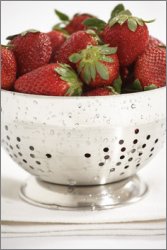What are Salicylates? Could Salicylates be Zapping Your Energy and Making You Feel Ill?
by www.SixWise.com
Salicylates occur naturally in many plant foods, acting as
a plant hormone. The compounds are also manufactured synthetically
and used to make painkilling drugs (aspirin and ibuprofen
are the most well-known), flavoring, solvents, certain skin
care products, perfume fixatives and preservatives.
|

Strawberries are very high in naturally occurring salicylates.
|
Salicylate Sensitivity
A portion of the population may be sensitive to salicylates,
much in the same way one may be sensitive to a food. A person
with salicylate sensitivities may be able to tolerate certain
foods and products that contain the compounds but not others.
Meanwhile, salicylates have a cumulative effect in the body,
meaning that a person may be able to tolerate a small amount
but will experience symptoms after excessive exposure. Even
consuming a salicylate-containing food cooked, versus raw,
can change the effect it may have.
Allergy-Like … Sometimes Contradictory … Symptoms
If a sensitivity is present, a person may experience allergy-like
symptoms that range from mild to life-threatening anaphylactic
shock. However, salicylates can cause a reaction that first
stimulates then depresses the central nervous system. So a
person may feel both lethargy and hyperactivity as a result.
|
Brand Names of Common Salicylate-Containing Drugs
Following is just a partial list of drugs that contain
salicylates in the United States, according to the Mayo
Clinic:
- Acuprin 81
- Amigesic
- Anacin Caplets and Tablets
- Aspirin Regimen Bayer Adult Low Dose
- Aspirin Regimen Bayer Regular Strength Caplets
- Bayer Children's Aspirin
- Bufferin Caplets and Tablets
- Disalcid
- Extra Strength Bayer Aspirin Caplets and Tablets
- Mobidin
- Mono-Gesic
- Norwich Aspirin
- P-A-C Revised Formula
- Regular Strength Ascriptin
- Salflex
- Salsitab
- Sloprin
- St. Joseph Adult Chewable Aspirin
- Tricosal
- Trilisate
- ZORprin
|
Other symptoms may include:
- Wheezing and trouble breathing
- Headaches
- Ear infections
- Changes in skin color, itching, rash or hives
- Mouth ulcers or rash
- Nasal congestion, coughing
|
- Sinusitis
- Swelling of the hands, feet, eyes and face
- Stomach pain
- Trouble concentrating
- Nasal polyps
- Cognitive and perceptual disorders
|
How Do I Know if I'm Sensitive?
If you have been experiencing any of the above symptoms and
are unable to explain the cause, an elimination diet can help
you determine if salicylates are to blame.
With an elimination diet, you eliminate foods and products
that contain salicylates (or only consume them in very low
levels), then keep track of your symptoms. If your symptoms
disappear, there's a good chance that you're sensitive to
salicylates.
If you suspect you are sensitive, this doesn't mean that
you can never eat a food that contains the compound. Remember
that some foods may affect you more than others, so you may
need to experiment. Other factors also add to the complication,
making certain foods and parts of foods less potentially problematic
than others:
-
Raw foods, dry foods and juices may contain more salicylates
than cooked food.
-
The highest levels of salicylates are found just under
the skin of certain fruits and vegetables, and in the
outer leaves of vegetables.
-
Salicylate levels decrease the riper a food gets.
In other words, if you are sensitive to salicylates in a
certain food, you may find you can tolerate it if it is very
ripe, peeled and cooked. (You should not consume any salicylates
if there is a risk of a severe reaction, of course.)
Where, Specifically, are Salicylates Found?
Salicylates are very widespread and occur in high levels
in blueberries, almonds, green peppers, cinnamon and many
other foods.
|

Salicylate sensitivity can cause headaches, ear infections,
mouth ulcers and a myriad of other symptoms.
|
The chart at the end of the article
gives a comprehensive look at which foods are high (and low)
in these compounds.
Salicylates are also part of many products, including:
- Acne products and wart or callus removers
- Fragrances, cosmetics and bubble baths
- Shampoos and conditioners
- Herbal remedies
- Lozenges
- Topical creams
- Mouthwash and mint-flavored toothpaste
- Shaving cream
- Sunscreens and tanning lotions
- Muscle pain creams
You should also watch out for the following ingredients if
you are trying to avoid salicylates:
- Aspirin
- Acetylsalicylic acid
- Artificial food colorings or flavorings
- Azo dyes
- Benzoates (preservatives)
- Benzyl salicylate
- Beta-hydroxy acid
- Choline salicylate
- Disalcid
- Ethyl salicylate
- Isoamyl salicylate
- Magnesium salicylate
|
- Menthol
- Methyl salicylate
- Mint
- Octylsalicylate
- Peppermint
- Phenylethyl salicylate
- Salicylic acid
- Salicylaldehyde
- Salicylamide
- Salsalate
- Sodium salicylate
- Spearmint
|
Though anyone can be sensitive to salicylates, it
is more likely to occur in people with moderate to severe
asthma or chronic rhinosinusitis. It is also more likely
to affect older adults and those with worsening asthma.
If you are sensitive to these compounds, your best bet to
avoiding any uncomfortable symptoms is to avoid any trigger
foods and/or products that may contain salicylates, and only
attempt to reintroduce them if you and your physician are
confident they will not cause a severe reaction.

Source: Allergy
Dietitian
Recommended Reading
Leptin:
What It Is, and Why It May Be the Most Powerful "Tool"
in the Battle Against Diabetes
Potatoes:
Once and For All, Are America's Favorite Vegetables Good for
You or Not?
Sources
Allergy
Health Online: Salicylate Sensitivity
Allergy
Dietitian: Salicylates in Foods
Mayo
Clinic: Salicylates